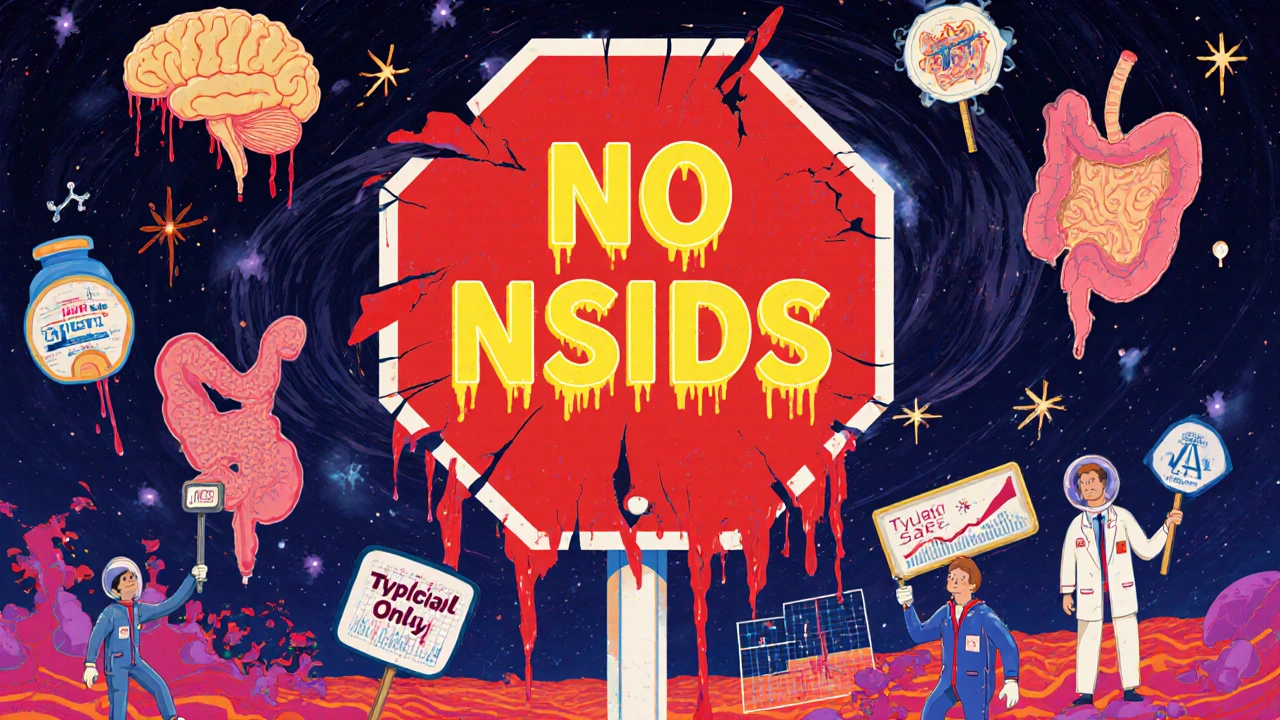NSAID Safety Checker for Warfarin Users
Check if your NSAID is safe to take with warfarin. The combination significantly increases your risk of dangerous bleeding.
Safe Alternatives
More than 3 million Americans take warfarin every day to prevent dangerous blood clots. At the same time, nearly 17 million are popping NSAIDs like ibuprofen or naproxen for back pain, headaches, or arthritis. What happens when these two mix? Warfarin and NSAIDs don’t just coexist-they create a perfect storm for uncontrolled bleeding. And most people have no idea how dangerous it is.
Why This Combination Is So Dangerous
Warfarin works by blocking vitamin K, which your body needs to make clotting factors. Without them, your blood can’t form clots easily-great for preventing strokes or pulmonary embolisms, but risky if you cut yourself or develop an ulcer. NSAIDs, on the other hand, stop your platelets from sticking together. They also wear down the protective lining in your stomach. So while warfarin slows clotting from the inside, NSAIDs make it harder for your body to even start the process-and leave your gut wide open for damage. The result? A two-pronged attack on your body’s ability to stop bleeding. Studies show this combo increases your overall bleeding risk by more than double compared to taking warfarin alone. It’s not just a small uptick. It’s a massive jump. And it doesn’t matter if you’re taking a low dose of ibuprofen or a prescription-strength naproxen. The risk is real at any level.Not All NSAIDs Are Created Equal
You might think all over-the-counter painkillers are the same. They’re not. Naproxen is the worst offender, increasing bleeding risk by more than four times compared to warfarin alone. Diclofenac isn’t far behind, tripling the risk. Even ibuprofen, the most common choice, raises the risk by nearly 80%. And meloxicam? It’s a hidden danger-prescribed often for arthritis, but linked to sharp spikes in INR levels. What about celecoxib or other COX-2 inhibitors? People used to think they were safer because they don’t hurt the stomach as much. But research from JAMA Internal Medicine and multiple meta-analyses show they’re just as dangerous when mixed with warfarin. The bleeding risk doesn’t drop-it just moves. You’re less likely to get a stomach ulcer, but more likely to bleed elsewhere: in your brain, lungs, or urinary tract.Where the Bleeding Happens
Most assume the biggest danger is a stomach bleed. And yes, gastrointestinal bleeding increases by more than two-fold with this combo. But that’s only part of the story. Intracranial bleeding-the kind that causes strokes-goes up by over three times. Pulmonary bleeding? Up 36%. Urinary tract bleeding? Up 57%. This isn’t just about stomach pain or black stools. It’s about internal bleeding that can kill you without warning. One patient on Reddit shared how their hemoglobin dropped from 14 to 8 g/dL in just 24 hours after taking ibuprofen for a headache. That’s a massive, life-threatening loss of blood. Emergency rooms see this all the time. A 2021 study of over 5,000 warfarin users found that 78% of those who bled while taking NSAIDs ended up hospitalized. Their average stay? More than five days.
NOACs Aren’t a Safe Escape
Many patients switch from warfarin to newer anticoagulants like apixaban, rivaroxaban, or dabigatran because they don’t need regular blood tests. But here’s the myth: NOACs are safe with NSAIDs. They’re not. Studies in Circulation and JACC show that combining NSAIDs with any oral anticoagulant-whether it’s warfarin or a NOAC-still leads to significantly higher bleeding rates. Apixaban might be slightly safer than warfarin in NSAID users, but the risk is still elevated. And with NOACs, there’s no easy way to reverse the effect if bleeding happens. With warfarin, you can give vitamin K or fresh frozen plasma. With dabigatran or rivaroxaban? You’re stuck waiting for the drug to clear, which can take hours or days. A 2023 study found that while co-prescribing NSAIDs with warfarin dropped 27% between 2015 and 2022, co-prescribing with NOACs jumped 35%. That’s not progress-it’s a dangerous shift in thinking. People think, “I’m on a newer drug, so I can still take my Advil.” That’s a deadly assumption.What Experts Say (And Why They’re So Firm)
The American College of Cardiology and the American Heart Association don’t mince words: NSAIDs should be avoided in patients on oral anticoagulants. That’s a Class I recommendation-the strongest level. It means the risk is clear, the evidence is solid, and the harm is severe. Dr. Søren Riis Petersen from Aarhus University Hospital led a 2023 study that found NSAID use doubled bleeding risk in patients on blood thinners. He emphasized it wasn’t just gastrointestinal-it affected multiple organs. The Anticoagulation Forum echoes this. Their 2022 guidelines say: if you absolutely must use an NSAID, use the lowest dose for the shortest time, avoid naproxen and meloxicam, check your INR three to five days after starting, and consider a proton pump inhibitor to protect your stomach. Harvard Health Publishing puts it simply: NSAIDs interfere with platelets. Platelets are your first line of defense against bleeding. Add that to warfarin’s effect on clotting factors, and you’re essentially disabling your body’s emergency response system.What You Should Do Instead
Acetaminophen (Tylenol) is the go-to alternative. It doesn’t affect platelets or the stomach lining. About 23.5% of warfarin users already use it as their painkiller of choice. And for localized pain-knees, shoulders, back-topical NSAIDs like diclofenac gel or ibuprofen cream are much safer. Only 1-5% of the drug enters your bloodstream, so the systemic risk drops dramatically. For chronic pain, physical therapy, heat/cold therapy, or even low-dose antidepressants (like duloxetine) for nerve pain can be effective without raising bleeding risk. Some patients turn to acupuncture or massage. These aren’t magic fixes, but they’re far safer than mixing NSAIDs with anticoagulants.
Why This Keeps Happening
You’d think after 70 years of warfarin use and decades of warnings, this would be a non-issue. But it’s not. A 2021 University of Michigan study found that in 68% of warfarin-related bleeding cases, patients didn’t tell their doctor they were taking OTC painkillers. They think, “It’s just Advil. It’s not a real drug.” Electronic health records in 42% of U.S. hospitals still don’t flag this interaction. So a doctor might prescribe warfarin and NSAIDs without ever seeing the warning. Even the FDA’s black box warning on NSAID labels doesn’t always make it into the prescribing workflow. And let’s not forget the cost. Warfarin-NSAID bleeding events cost the U.S. healthcare system $1.87 billion a year. That’s not just hospital bills-it’s lost workdays, long-term disability, emergency transports, and follow-up care. This isn’t a rare side effect. It’s a systemic failure.What to Watch For
If you’re on warfarin or any anticoagulant and take NSAIDs-even once-know the signs of bleeding:- Bright red or black, tarry stools
- Unexplained bruising, especially large or spreading
- Bleeding gums when brushing teeth
- Headaches, dizziness, confusion (possible brain bleed)
- Dark urine or blood in urine
- Shortness of breath or chest pain (lung bleed)
- Severe abdominal pain
The Bottom Line
There is no safe way to combine warfarin and NSAIDs. Not low dose. Not short term. Not even with monitoring. The data is too clear, the consequences too severe. The idea that “I’ve been doing this for years and nothing happened” is a gamble with your life. Your body doesn’t build tolerance to this interaction-it just gets luckier. Switch to acetaminophen. Use topical gels. Talk to your doctor about non-drug pain options. If you’re on a NOAC, don’t assume you’re protected. The risk is still there. This isn’t a gray area. It’s a red line. Cross it, and you’re playing Russian roulette with your internal organs.Can I take ibuprofen with warfarin if I only use it occasionally?
No. Even occasional use of ibuprofen with warfarin increases your bleeding risk by nearly 80%. There’s no safe threshold. The interaction happens at the molecular level-your platelets and clotting factors don’t distinguish between daily or occasional use. The risk is cumulative and unpredictable. Acetaminophen is the only over-the-counter pain reliever recommended as a safe alternative.
Are COX-2 inhibitors like celecoxib safer than regular NSAIDs with warfarin?
No. Studies from JAMA Internal Medicine and multiple meta-analyses confirm that COX-2 inhibitors carry the same bleeding risk as traditional NSAIDs when taken with warfarin. While they may cause less stomach irritation, they still impair platelet function and increase the risk of bleeding in the brain, lungs, and other organs. They are not a safer option.
What should I do if I accidentally took an NSAID while on warfarin?
Stop taking the NSAID immediately. Monitor yourself for signs of bleeding: unusual bruising, dark stools, dizziness, or blood in urine. Contact your anticoagulation clinic or doctor right away. They’ll likely check your INR within 24-48 hours. If you have any symptoms of bleeding, go to the emergency room. Do not wait.
Can I use topical NSAIDs like diclofenac gel with warfarin?
Yes. Topical NSAIDs deliver less than 5% of the drug into your bloodstream, so they don’t significantly affect platelets or INR levels. They’re a safe alternative for localized pain like arthritis in the knee or shoulder. Always use them as directed and avoid applying them over large areas or broken skin.
Why do some doctors still prescribe NSAIDs with warfarin?
Some doctors may not be fully aware of the latest guidelines, or they underestimate the risk because the patient seems fine. Others may assume the patient will stop the NSAID on their own. But research shows 42.6% of warfarin users still get NSAID prescriptions annually. This is a known gap in care. If your doctor prescribes an NSAID while you’re on warfarin, ask for evidence that it’s safe-and insist on alternatives.
Is it safe to take NSAIDs with newer anticoagulants like Eliquis or Xarelto?
No. While newer anticoagulants like apixaban (Eliquis) and rivaroxaban (Xarelto) have fewer drug interactions overall, combining them with NSAIDs still significantly increases bleeding risk. Studies show the risk is similar to warfarin combinations. The idea that NOACs are “safe” with NSAIDs is a dangerous myth. Avoid NSAIDs completely if you’re on any oral anticoagulant.

Ross Ruprecht
November 23, 2025 AT 06:06Ugh, another post telling me I can’t take ibuprofen. I’ve been doing this for 10 years and I’m fine. Stop scaring people.
Vivian C Martinez
November 24, 2025 AT 21:07Hey, I get it-pain is real. But if you’re on warfarin, your body’s already playing Jenga with your clotting system. Adding NSAIDs? That’s pulling the last block. Please, for your own sake, switch to Tylenol. It’s not a sacrifice, it’s a survival hack.
Bryson Carroll
November 25, 2025 AT 08:27Look I’ve read the studies and honestly this post is just fearmongering wrapped in a medical journal. Everyone knows NSAIDs are risky but people take them anyway because life doesn’t stop just because you’re on blood thinners. You think your INR is going to save you from a bad knee? Please. The real danger is overmedicalizing normal human pain
Jennifer Shannon
November 26, 2025 AT 10:54It’s funny how we treat medicine like it’s a menu-pick one, add a side, maybe a dessert of ibuprofen-and expect our bodies to politely ignore the chemical chaos we’ve unleashed. Warfarin is a delicate ballet of molecular inhibition, and NSAIDs? They’re the drunk guy who kicks over the piano. It’s not just about bleeding-it’s about how deeply we’ve normalized ignoring our own biology. We’re not machines. We’re fragile, beautifully flawed systems trying to survive in a world that thinks ‘over-the-counter’ means ‘harmless.’
Kezia Katherine Lewis
November 27, 2025 AT 02:58From a clinical pharmacology standpoint, the pharmacokinetic and pharmacodynamic synergy between vitamin K antagonists and non-selective COX inhibitors creates a synergistic anticoagulant and antiplatelet effect that significantly elevates the risk of major hemorrhagic events, particularly GI and intracranial. The evidence base is robust and replicated across multiple large-scale cohort studies and meta-analyses. The Class I recommendation is not merely advisory-it is a standard of care.
Henrik Stacke
November 27, 2025 AT 04:32My mum was on warfarin for AFib. Took a few naproxen for her arthritis. Ended up in A&E with a bleed in her thigh. She didn’t even know it was dangerous. I’ve since made her a little card: ‘No NSAIDs. Ever.’ She laughs now. But I won’t let her forget. This isn’t just info-it’s a lifeline.
Manjistha Roy
November 29, 2025 AT 01:14I am from India and here many people take aspirin daily for heart health and also ibuprofen for joint pain. Doctors rarely warn them. This article is so important for global awareness. We need to translate this into Hindi, Tamil, Bengali. This is not just an American problem. This is a global silent killer.
Jennifer Skolney
November 29, 2025 AT 21:31Just switched to Tylenol after reading this and my knee feels the same 🙌 no more scary blood tests after a headache. Seriously, y’all-your body is not a lab experiment. Protect it. 💪
JD Mette
December 1, 2025 AT 18:39I had a friend who had a brain bleed after taking Aleve for a migraine. He was on rivaroxaban. He survived, but now has permanent vision damage. I wish someone had told him this. Please, just don’t risk it.
Olanrewaju Jeph
December 2, 2025 AT 21:28This is the kind of information that saves lives. In my community, people think if it’s sold in a pharmacy, it’s safe. Thank you for speaking up. I’m sharing this with my uncle who’s on warfarin and takes ibuprofen every Sunday for his back.
Dalton Adams
December 3, 2025 AT 08:37Let’s be real-this post is just a marketing ploy for acetaminophen. Tylenol is toxic to the liver if you overdo it, but no one screams about that. And what about people with liver disease? You’re swapping one risk for another. And don’t even get me started on how expensive brand-name pain meds are. This isn’t a simple ‘just use Tylenol’ fix-it’s a systemic failure of healthcare accessibility. 😒
Kane Ren
December 3, 2025 AT 09:44You’re not alone. I was skeptical too-until I saw my dad’s INR spike to 9.5 after a weekend of ibuprofen for his gout. We almost lost him. Now I keep a list of safe pain options taped to his fridge. Small changes save lives. 💙
Charmaine Barcelon
December 3, 2025 AT 13:37You’re all overreacting. It’s just a little painkiller. If you can’t handle a little bleeding, maybe you shouldn’t be on blood thinners in the first place. Stop being so dramatic.
Karla Morales
December 3, 2025 AT 20:29📊 DATA: NSAID + anticoagulant = 2.1x higher major bleeding risk. 📉 78% hospitalization rate. 💉 No reversal agents for NOACs. 🚨 This isn’t opinion-it’s epidemiology. Stop romanticizing risk. 🧠
Javier Rain
December 4, 2025 AT 04:25Listen-I’m not here to scare you. I’m here to empower you. You’ve got options. Topical gels. Physical therapy. Acupuncture. Even a good foam roller. Your pain matters, but your life matters more. Don’t let a quick fix cost you your future. You got this.